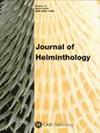绘制西非和中非血吸虫杂交种分布图
IF 1.3
3区 生物学
Q4 PARASITOLOGY
引用次数: 0
摘要
在传染病的进化过程中,寄生物种的杂交是一个新出现的健康问题,尤其是在血吸虫属的吸虫中。由于这种杂交的后果仍相对未知,因此需要进一步的研究来阐明这种疾病的流行病学和杂交血吸虫的生物学特性。在本文中,我们详细综述了已发表的血吸虫杂交结果。本综述采用制图方法,介绍了在西非(尼日尔、马里、塞内加尔、科特迪瓦、贝宁、尼日利亚)和中非(喀麦隆、加蓬、刚果民主共和国)调查人类(血吸虫、几内亚血吸虫和intervalatum血吸虫)和动物(牛血吸虫和库拉索尼血吸虫)血吸虫杂交的研究,以及这些研究因低估了血吸虫在非洲的分布而存在的局限性。本综述提供了有关研究的信息,这些研究强调了血吸虫类杂交种以及发现这些杂交种的地区,尤其是西非和中非。本文章由计算机程序翻译,如有差异,请以英文原文为准。
Mapping of schistosome hybrids of the haematobium group in West and Central Africa
Hybridization of parasitic species is an emerging health problem in the evolutionary profile of infectious disease, particularly within trematodes of the genus Schistosoma. Because the consequences of this hybridization are still relatively unknown, further studies are needed to clarify the epidemiology of the disease and the biology of hybrid schistosomes. In this article, we provide a detailed review of published results on schistosome hybrids of the haematobium group. Using a mapping approach, this review describes studies that have investigated hybridization in human (S. haematobium, S. guineensis , and S. intercalatum ) and animal (S. bovis and S. curassoni ) schistosome species in West Africa (Niger, Mali, Senegal, Côte d’Ivoire, Benin, Nigeria) and in Central Africa (Cameroon, Gabon, Democratic Republic of Congo), as well as their limitations linked to the underestimation of their distribution in Africa. This review provides information on studies that have highlighted hybrid species of the haematobium group and the regions where they have been found, notably in West and Central Africa.
求助全文
通过发布文献求助,成功后即可免费获取论文全文。
去求助
来源期刊

Journal of Helminthology
生物-动物学
CiteScore
2.80
自引率
12.50%
发文量
127
审稿时长
3 months
期刊介绍:
Journal of Helminthology publishes original papers and review articles on all aspects of pure and applied helminthology, particularly those helminth parasites of environmental health, medical or veterinary importance. Research papers on helminths in wildlife hosts, including plant and insect parasites, are also published along with taxonomic papers contributing to the systematics of a group. The journal will be of interest to academics and researchers involved in the fields of human and veterinary parasitology, public health, microbiology, ecology and biochemistry.
 求助内容:
求助内容: 应助结果提醒方式:
应助结果提醒方式:


